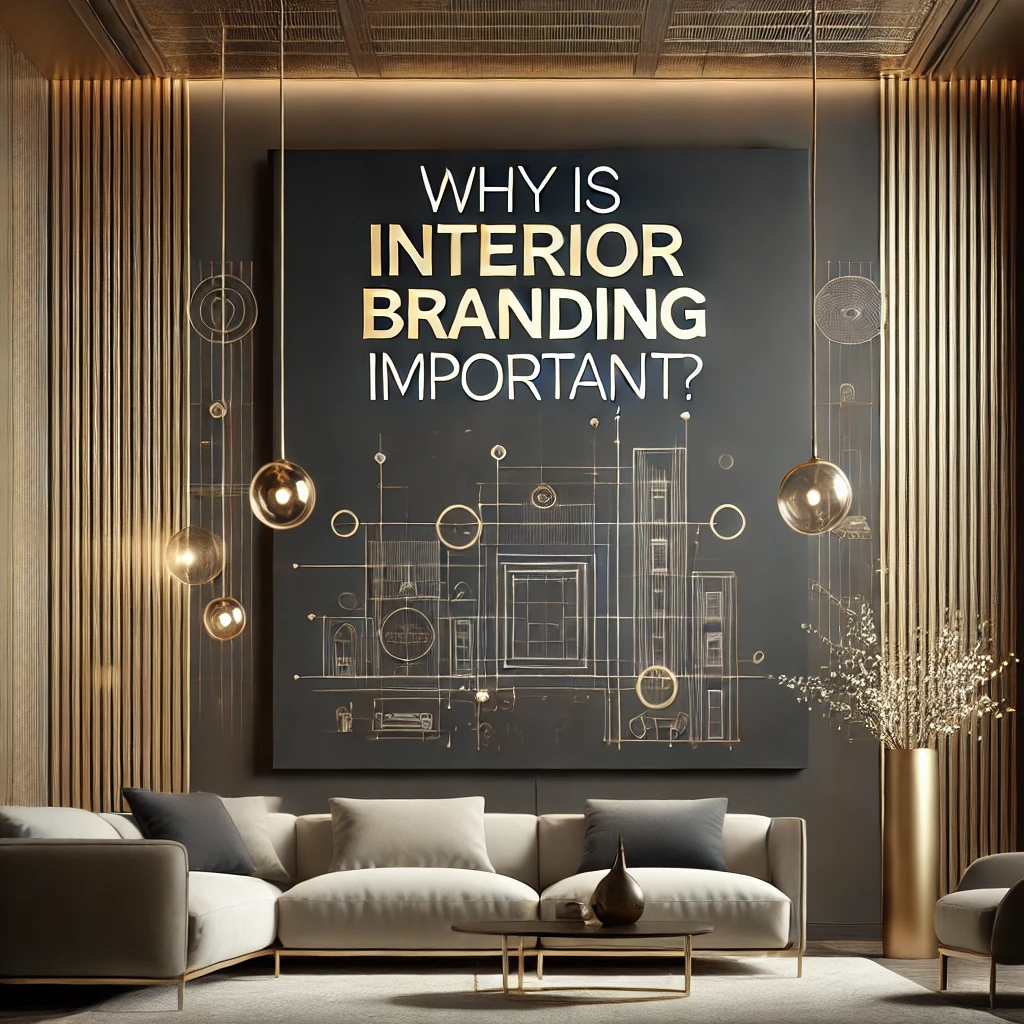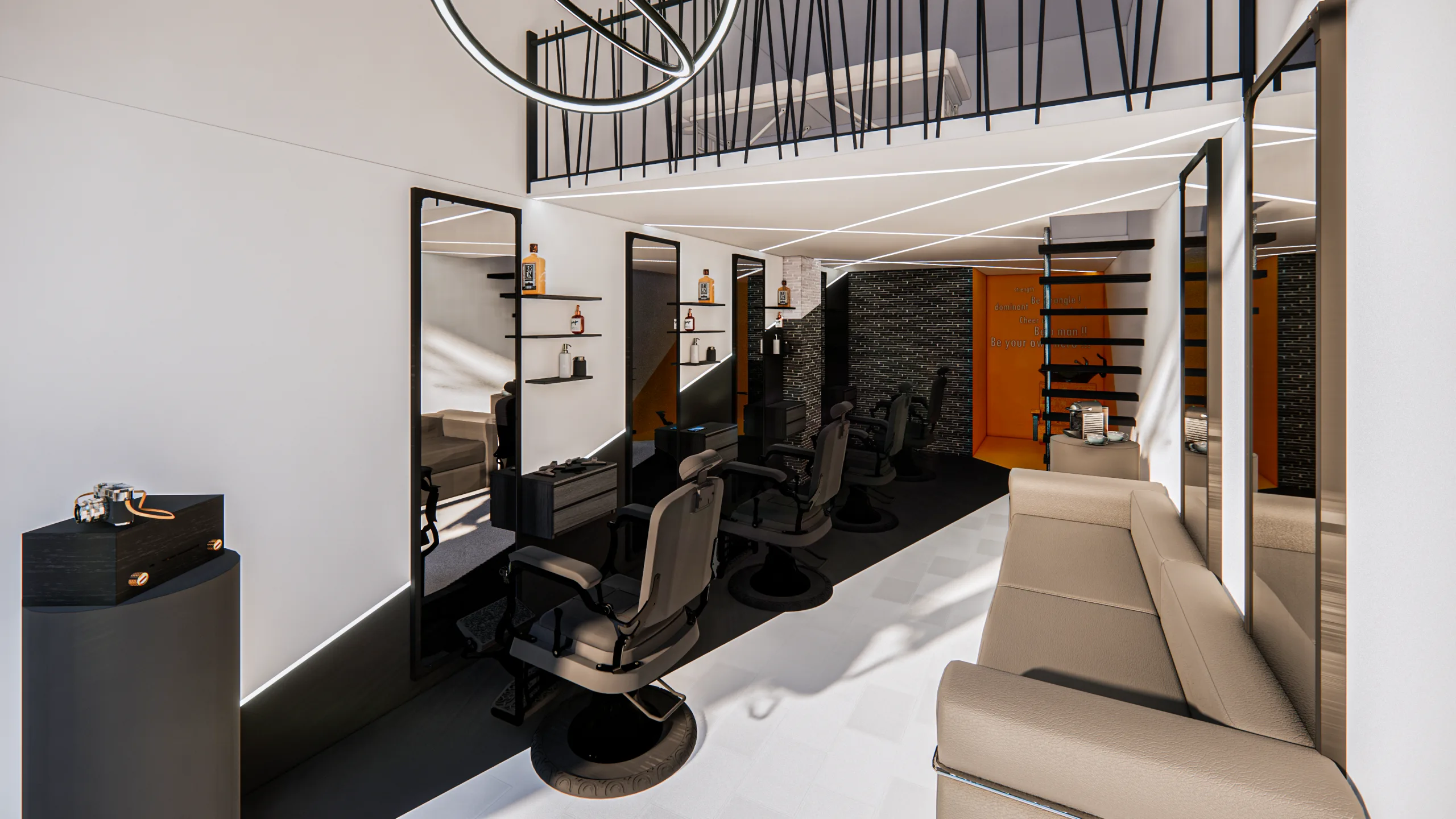Chi'Livin.
In today’s highly competitive business environment, creating a memorable and consistent brand identity is crucial for success. While many companies focus on logos, slogans, and advertising, one often overlooked aspect is how a brand is represented within physical spaces. Interior branding is the art of aligning the design of a space with a brand’s identity, creating an immersive experience that resonates with customers. In this blog, we will explore the importance of interior branding, the role of an interior designer in achieving it, and analyze how Chi’Livin implemented it in the Midas The Barber project.

Branding is the process of creating a unique identity for a business, which differentiates it from competitors and resonates with customers. A strong brand communicates a company’s values, mission, and personality, forming the foundation of customer loyalty and trust.
Known for its consistent messaging, Nike’s branding revolves around the themes of athleticism, empowerment, and performance. The iconic swoosh logo and “Just Do It” slogan are instantly recognizable worldwide. Nike’s retail stores are designed to inspire and engage customers, reflecting the brand’s commitment to innovation and excellence.

Apple’s brand identity is centered on innovation, simplicity, and elegance. Its products and retail stores reflect a minimalist aesthetic that emphasizes design and user experience. The Apple Store is a perfect example of how interior branding reinforces the company’s values of simplicity and cutting-edge technology, creating a seamless and immersive customer experience.

You heard it right—Chi’Livin is more than just an architecture and interior design agency. We represent a lifestyle, an identity, and a personality.
Building Chi’Livin wasn’t easy. It took time, effort, and a clear vision. We’ve grown into a brand with strong values and a unique identity, much like Nike or Apple. We’re not just about creating spaces; we’re about creating experiences that reflect who you are and how you want to live.

Interior branding is the application of a brand’s identity within a physical space. It involves using design elements such as color, materials, layout, and decor to create an environment that reflects the brand’s personality and values. Interior branding is not just about making a space look attractive; it’s about creating a space that tells a brand’s story and makes a lasting impression on customers.
Interior branding is more than just looks; it’s key to boosting your business. By designing a space that matches your brand’s identity, you attract customers, build trust, and drive success. It’s about creating an environment that truly connects with your customers, reflecting your brand’s values and fostering long-term growth and loyalty. Here are the top business benefits that interior branding brings to you:
The design of a space can shape how customers perceive a brand. A well-branded interior can enhance customer experience and reinforce brand loyalty. For example, a high-end boutique with luxurious interiors can make customers feel valued and reinforce the perception of exclusivity.
Interior branding helps businesses stand out by creating unique, memorable environments that embody their brand identity. In a crowded market, a distinct and well-branded physical space can be a significant competitive advantage.
Ensuring that physical spaces align with other branding elements (like online presence and advertising) creates a cohesive brand experience. Consistency across all touchpoints strengthens brand recognition and reinforces customer trust.
An interior design agency is instrumental in transforming a brand’s identity into a tangible, immersive experience within a physical space. Their role in interior branding extends far beyond selecting furniture and colors; it’s about strategically designing an environment that embodies the brand’s values and resonates with its target audience. Here’s how an interior design agency contributes to successful interior branding:
The agency begins by deeply understanding the brand’s mission, values, and goals. This foundation allows them to create a design that not only looks good but also aligns with the brand’s identity and business objectives.
The agency meticulously selects design elements such as materials, colors, and layouts that reflect the brand’s personality. Whether it’s a luxurious ambiance for a high-end brand or a vibrant, dynamic space for a youthful brand, each element is chosen to reinforce the brand’s message.
Effective space planning is crucial in ensuring that the physical environment supports the brand’s goals. The agency designs layouts that enhance customer flow, promote interaction, and create a welcoming atmosphere that aligns with the brand’s identity.
The choice of materials and colors plays a significant role in conveying a brand’s identity. An interior design agency carefully selects these elements to evoke the desired emotions and associations, ensuring visual consistency across all touchpoints.
The agency integrates recognizable brand symbols, motifs, and decor items into the design, making the space instantly identifiable with the brand. This not only enhances brand recognition but also creates a cohesive and immersive environment.
Beyond aesthetics, the agency ensures that the space is functional and serves the needs of the business and its customers. This includes designing ergonomic, accessible spaces that enhance comfort and usability, all while maintaining alignment with the brand’s identity.
Through thoughtful design, the agency crafts spaces that tell the brand’s story and engage customers on a deeper level. By creating an environment that reflects the brand’s journey, values, and aspirations, the agency helps build strong emotional connections with customers.
Consistency is key to successful interior branding. A consistent design approach ensures that all elements within a space align with the brand’s identity. This includes:
A well-branded space must also be functional. It’s not enough for a space to look good; it must also serve the needs of the business and its customers. Key considerations include:
Interior branding should tell a story. Each element within the space should contribute to a narrative that reflects the brand’s journey, values, and aspirations. Storytelling can be achieved through:
Midas The Barber is not just a barbershop; it’s a luxurious grooming experience that embodies sophistication and elegance, inspired by the legendary King Midas. Located in a prime urban area, Midas The Barber sought to distinguish itself from conventional barbershops by creating an environment that exudes exclusivity and refinement. For a more detailed exploration of the concept and vision behind Midas The Barber, visit our dedicated Concept Page.
The Midas brand is visually anchored by a striking color palette of gold and black. Gold symbolizes wealth, success, and luxury—values deeply intertwined with the brand’s identity. Black adds a layer of sophistication and timelessness, creating a sense of exclusivity and elegance.
Midas The Barber is built on values of luxury, quality, and customer-centricity. Every aspect of the brand is designed to provide clients with a premium experience, from the grooming services to the ambiance. The brand also emphasizes attention to detail, craftsmanship, and a personalized approach to customer service, ensuring that every visit feels unique and tailored.
The brand identity of Midas The Barber revolves around the idea of transformation—turning ordinary grooming into an extraordinary, luxurious ritual. This identity is reflected not only in the services offered but also in the atmosphere, which is designed to make every client feel like royalty.
In designing Midas The Barber, the principles of consistency, functionality, and storytelling were at the forefront of every decision, ensuring that the brand’s identity was deeply embedded into every aspect of the interior and exterior space.
We consistently applied the brand’s signature colors—black, gold, and white—across all elements to reinforce the identity. This color scheme was crucial in creating a cohesive look that immediately communicates luxury and sophistication.
Every line in the design guides the eye to the golden focal points, echoing the story of Midas’s transformative touch. The strategic placement of these elements not only enhances the aesthetic appeal but also reinforces the narrative of the brand, making the space feel like a journey through the legend of King Midas.
Leather chairs, steel accents, and a robust coffee table were chosen to embody the brand’s masculine ethos while ensuring comfort and style. The design also prioritized customer flow and interaction, creating a space that is both practical and aligned with the brand’s luxurious image.

Every line in the design guides the eye to the golden focal points, echoing the story of Midas's transformative touch.
We consistently applied the brand's signature colors—black, gold, and white—across all elements to reinforce the identity..
This image perfectly encapsulates how these three key elements—consistency, storytelling, and functionality—were seamlessly integrated into the design of Midas The Barber. The result is a space that not only looks and feels luxurious but also tells a powerful story that resonates with every client who walks through the door.
Interior branding is essential for creating a cohesive and memorable brand experience. By integrating branding into the physical environment, businesses can enhance customer satisfaction, build loyalty, and differentiate themselves in the market. A well-executed interior branding strategy not only strengthens a brand’s identity but also contributes to its long-term success.
Investing in interior branding is not just about aesthetics; it’s about creating a space that tells your brand’s story and resonates with your customers on a deeper level. Whether you’re a retail store, a restaurant, or an office, interior branding can transform your space into a powerful tool for building brand loyalty and driving business growth.
If you’re ready to elevate your brand through interior design, Chi’Livin is here to help. Explore our detailed post about the Midas The Barber project to see how we can transform your space into a powerful extension of your brand.
Contact us today for a consultation by simply putting your infos below, and let’s start creating a space that truly reflects your brand’s identity.
Chi’Livin is more than just an architecture and interior design agency. We embody a lifestyle, an identity, a personality.
Anywher ST., Any City.

